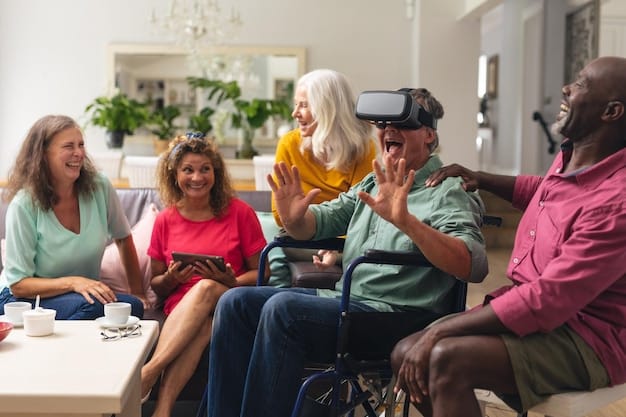Streaming Service Accessibility Features: A Guide for US Users

Accessibility features in streaming services are crucial for US users with diverse needs, offering tools like closed captions, audio descriptions, and navigation enhancements to ensure equitable access to entertainment and information, fostering a more inclusive digital media landscape nationwide.
In today’s digital age, streaming services have become central to how many Americans consume entertainment and information. But how accessible are these platforms for everyone? This comprehensive guide explores essential Streaming Service Accessibility Features: A Comprehensive Guide for US Users, ensuring an inclusive viewing experience for all.
Understanding the Landscape of Digital Accessibility
Digital accessibility is more than just a buzzword; it’s a fundamental right that ensures equal access for individuals with disabilities. In the realm of streaming services, this means designing platforms and content so that they can be fully enjoyed by everyone, regardless of their sensory, cognitive, or physical abilities. While the internet has opened up a world of content, its true potential is only realized when it is built with inclusivity at its core.
For US users, understanding the various accessibility features available on streaming platforms is not just about compliance, but about empowering choice and participation. These features range from visual aids for the hearing impaired to auditory clues for the visually impaired, and even navigation enhancements for those with motor difficulties. The ultimate goal is to remove barriers, allowing every viewer to engage with stories, documentaries, and live events on their own terms. It fosters a more connected and understanding society.
The Importance of Accessible Content
Providing accessible content isn’t merely a matter of good practice; it reflects a commitment to diversity and inclusion. When content is not accessible, it alienates a significant portion of the population, limiting their entertainment options and their ability to participate in communal experiences surrounding popular media.
- Broadened Audience Reach: Accessible features open content to millions of users who might otherwise be excluded, expanding market potential.
- Legal Compliance: Adhering to standards like the Americans with Disabilities Act (ADA) and Section 508 helps avoid legal challenges.
- Enhanced User Experience: Features like captions can benefit everyone, including those in noisy environments or learning a new language.
- Social Responsibility: It demonstrates a commitment to ethical design and social equity, building goodwill and a positive brand image.
Ultimately, a robust commitment to accessibility enriches the entire viewing ecosystem, benefiting both content creators and consumers alike. Content that is designed with accessibility in mind from the outset is often more thoughtfully created and reaches a broader, more engaged audience. This initial investment in accessible design prevents costly retrofitting and ensures a seamless experience for all users.
Decoding Closed Captions and Subtitles
Closed captions and subtitles are perhaps the most widely recognized accessibility features in streaming, yet their nuances are often misunderstood. While both display text on screen that corresponds to spoken dialogue, they serve distinct purposes and cater to different needs.
Closed captions (CC) are designed primarily for viewers who are deaf or hard of hearing. They not only transcribe dialogue but also include non-speech elements crucial for understanding the narrative, such as sound effects, musical cues, and speaker identification. This comprehensive textual representation ensures that the full audio experience is conveyed to those who cannot hear it. The ability to toggle them on or off and customize their appearance makes them a versatile tool for accessibility.
Closed Captions (CC) vs. Subtitles for the Deaf or Hard of Hearing (SDH)
While often used interchangeably, there’s a subtle but important distinction. Closed captions include all audio information, whereas “Subtitles for the Deaf or Hard of Hearing” (SDH) are essentially subtitles that also incorporate non-dialogue audio cues, much like closed captions, but are typically embedded within the video stream rather than being a separate track.
- Closed Captions (CC): Can be turned on or off, often customizable in appearance (text size, color, background). Include dialogue, sound effects, and speaker identification.
- SDH (Subtitles for the Deaf or Hard of Hearing): Function similarly to CC but are often burned into the video or presented as a single language track. They also include sound effects and speaker IDs.
- Standard Subtitles: Translate dialogue from a foreign language or provide text for the spoken language, assuming the viewer can hear the audio. They do not typically describe sound effects.
The availability and quality of closed captions vary significantly across streaming platforms and content providers. Many services are striving for 100% captioning, but older content or live broadcasts may present challenges. Users should look for options to customize caption appearance, ensuring readability and personal preference. The goal is to provide a seamless and informative text experience that truly mirrors the audio, allowing for full comprehension and enjoyment of the content.
Embracing Audio Descriptions for Visual Impairment
For viewers who are blind or have low vision, audio descriptions are transformative. These are narrations inserted into the natural pauses of a program’s dialogue, providing verbal descriptions of key visual elements that are essential for understanding the plot, characters, and setting. This auditory translation of visual information bridges the gap between what is seen and what is understood, allowing visually impaired users to fully immerse themselves in the story.
Audio descriptions go beyond simply describing what’s on screen; they contextualize the visuals, explaining actions, gestures, costumes, scene changes, and on-screen text that would otherwise be inaccessible. This service ensures that the narrative flow remains unbroken and that the emotional impact of visual storytelling is conveyed through sound. For many, it’s the difference between merely hearing a story and truly experiencing it.
How Audio Descriptions Work
Professional narrators record these descriptions, carefully scripting them to fit within the existing soundtrack without interfering with dialogue or crucial sound effects. The process requires precision and an understanding of narrative pacing. Streaming services integrate these separate audio tracks, allowing users to toggle them on or off as needed.
The rise of audio description has been gradual but steady, driven by advocacy from disability rights groups and evolving accessibility mandates. While not all content offers audio descriptions, their presence is growing, reflecting a broader commitment to inclusive media. It’s a feature that truly opens up the world of visual storytelling to an entire community of viewers who rely on auditory information to engage with content. This subtle yet powerful feature democratizes access to visual media.
Navigational Accessibility and User Interface
True accessibility extends beyond just the content; it encompasses the entire user experience, starting with the navigation of the streaming platform itself. For many US users with physical or cognitive disabilities, how they interact with the streaming service’s interface can be as crucial as the content features. This includes the ease of finding shows, adjusting settings, and controlling playback.
An accessible user interface means intuitive design, clear visual cues, and compatibility with assistive technologies. For instance, consistent layout and clear labeling help users with cognitive impairments navigate without confusion. Predictable navigation patterns reduce the learning curve and foster independence. The aim is to make the entire journey, from logging in to selecting a movie, as smooth and barrier-free as possible.
Keyboard Navigation and Screen Readers
One of the most critical aspects of navigational accessibility is support for keyboard navigation. Many users with motor impairments or visual impairments rely solely on a keyboard or assistive devices like switch controls to interact with digital interfaces. This means all functions, including play, pause, volume, search, and menu selections, should be operable without a mouse.
- Keyboard Shortcuts: Essential for quick and efficient navigation without a mouse.
- Focus Indicators: Clearly highlight which element is currently selected, helping users track their position.
- Screen Reader Compatibility: The interface must be properly coded with ARIA (Accessible Rich Internet Applications) labels and semantic HTML so that screen readers can accurately interpret and vocalize elements for visually impaired users.
- Voice Control Support: Integration with voice assistants and voice control features can offer an alternative means of interaction for those who find typing or physical navigation challenging.

Additionally, ensuring compatibility with screen readers is paramount. Screen readers verbally describe what’s on screen, allowing blind users to understand and interact with the interface. This requires proper semantic markup and unique identifiers for elements, so the screen reader can accurately convey meaning. Without these considerations, even the most accessible content can remain out of reach. Companies must prioritize testing with real users and assistive technologies to ensure a genuinely inclusive experience.
Advanced Features and Future Trends
While closed captions, audio descriptions, and navigable interfaces form the backbone of streaming accessibility, the landscape is continuously evolving. Innovators are developing more advanced features that push the boundaries of inclusion, promising an even richer experience for US users with disabilities.
These emerging technologies often leverage artificial intelligence and machine learning to automate and enhance existing features or introduce entirely new ways of interacting with content. The goal is to move beyond mere compliance to truly personalized and seamless accessibility solutions. For example, AI-driven tools can improve the accuracy of captions in real-time or create more natural-sounding audio descriptions.
Interactive & Personalized Accessibility
The future of streaming accessibility likely lies in greater personalization and interactivity. Imagine a viewer being able to fine-tune the speed of captions, the voice of the audio describer, or even the level of descriptive detail provided. These adaptive features would cater to individual preferences and varying levels of need.
- Customizable Player Controls: Beyond basic play/pause, users may gain more control over font sizes, colors, and alternative control methods.
- AI-Powered Descriptions and Captions: Real-time generation and enhancement of accessibility features for live content or user-generated media.
- Haptic Feedback: The potential for tactile feedback, especially for certain types of content or navigational cues, could add another layer of sensory enhancement.
- Sign Language Integration: Some platforms are exploring dedicated sign language interpretation windows for certain shows, offering a direct visual translation of dialogue.
Furthermore, the integration of biometric data or user profiles could allow platforms to automatically apply preferred accessibility settings, creating a truly tailored viewing experience from the moment a user logs in. As technology progresses, the possibilities for making streaming content universally accessible become more expansive and exciting. Investment in these areas signals a genuine commitment to inclusivity rather than just meeting minimum requirements.
Advocacy, Standards, and Compliance in the US
The advancement of streaming service accessibility in the US largely stems from a combination of persistent advocacy, evolving legal standards, and a growing understanding of the market. Disability rights organizations and consumer groups play a pivotal role in pushing for stronger regulations and corporate responsibility, ensuring that technology serves all members of society.
Key legislation and guidelines, such as the Americans with Disabilities Act (ADA) and Section 508 of the Rehabilitation Act, provide crucial frameworks. While the application of these laws to private streaming services has sometimes been subject to interpretation and litigation, the general trend indicates a clear expectation for digital content to be accessible. Compliance isn’t static; it evolves with technology and societal understanding.
Key Regulatory Bodies & Guidelines
Several organizations and guidelines shape the accessibility landscape in the US:
- Federal Communications Commission (FCC): Oversees captioning requirements for television programming that is then streamed online.
- Department of Justice (DOJ): Interprets and enforces the ADA, increasingly applying it to websites and digital services.
- Web Content Accessibility Guidelines (WCAG): Though not legally binding in themselves, these international guidelines (developed by the W3C) are widely adopted benchmarks for digital accessibility. WCAG 2.1 and upcoming WCAG 2.2 provide comprehensive technical standards.
- Consumer Advocacy Groups: Organizations like the National Association of the Deaf (NAD) and the American Council of the Blind (ACB) actively campaign for better accessibility and may initiate legal action to ensure compliance.

The ongoing dialogue between legal frameworks, technological capabilities, and user needs continues to shape the future of streaming accessibility. Compliance ensures basic access, but a true commitment to inclusion means exceeding minimum requirements and proactively designing for diverse abilities. This proactive approach benefits everyone by creating more robust and user-friendly platforms. It’s a dynamic area where continuous improvement is the norm.
Empowering US Users: Choosing Accessible Platforms
For US users seeking accessible streaming experiences, understanding which platforms prioritize inclusivity is key. While many services are making strides, there’s still a spectrum of commitment and feature implementation. Empowering yourself with this knowledge allows you to make informed choices and advocate for better accessibility where needed.
When selecting a streaming service, consider not only the content library but also the breadth and quality of its accessibility features. A truly inclusive platform will go beyond basic captions, offering robust options for audio descriptions, customizable interfaces, and compatibility with a wide range of assistive technologies. It’s about finding a service that truly caters to all your viewing needs.
Questions to Ask Before Subscribing
Before committing to a streaming service, it’s beneficial to ask a few key questions regarding its accessibility offerings:
- Captioning Quality: How accurate are the captions, and are they available for all content, including live events and older titles?
- Audio Description Availability: Is the audio description feature offered on a significant portion of its library, and can it be easily activated?
- Navigational Ease: Can the entire interface be easily navigated using only a keyboard or screen reader? Are menus clear and intuitive?
- User Customization: Are there options to customize text size, color, contrast, or playback speed to suit individual preferences?
- Dedicated Support: Does the service offer clear information and support for accessibility features, including dedicated help resources?
Ultimately, the power to drive further improvements lies with the consumer. By choosing platforms that prioritize accessibility and providing feedback to those that fall short, US users can collectively push the industry towards a more inclusive future. Your choices as a subscriber send a clear message to content providers about the importance of equitable access. This collective action can lead to significant positive change across the industry’s landscape.
| Key Feature | Brief Description |
|---|---|
| 🗣️ Closed Captions | Text display of dialogue and environmental sounds, crucial for deaf/hard of hearing users. |
| 👁️ Audio Descriptions | Narration of visual elements for blind/low-vision users, inserted during natural pauses. |
| ⌨️ Keyboard Navigation | Ability to control the entire interface using only a keyboard or assistive devices. |
| ⚙️ Customizable UI | Options to adjust text size, font, colors for better readability for diverse users. |
Frequently Asked Questions About Streaming Accessibility
▼
Closed captions (CC) are primarily for deaf or hard of hearing viewers, transcribing dialogue and including non-speech elements like sound effects and speaker identification. Subtitles, conversely, typically only translate dialogue from a foreign language or provide text for the spoken language, assuming the viewer can hear.
▼
Audio descriptions provide narration of key visual elements, such as character actions, expressions, and scene changes, within the natural pauses of a program’s dialogue. This allows blind or low-vision users to understand the plot and setting, fully immersing them in the visual story through sound.
▼
Keyboard navigation is crucial for users with motor impairments or visual impairments who cannot use a mouse. It ensures that all functions, from selecting content to controlling playback, can be operated using only a keyboard, assistive devices like switch controls, or screen readers, enhancing overall usability and independence.
▼
While the Americans with Disabilities Act (ADA) and other regulations suggest broad requirements for digital accessibility, the specific application to streaming services has evolved. The FCC mandates captioning for streamed TV content, and general accessibility best practices like WCAG are widely adopted. Many services are proactively implementing features to comply and enhance user experience.
▼
Look for dedicated accessibility sections on the service’s website or help center. Many platforms provide detailed information about their features, including specific content availability for audio descriptions or customization options for captions. Reviewing user forums or accessibility-focused reviews can also offer practical insights into a service’s true inclusivity.
Conclusion
The journey towards truly inclusive streaming experiences for US users is an ongoing evolution, driven by technological advancements, robust advocacy, and a shared commitment to equitable access. From the foundational elements of closed captions and audio descriptions to the sophisticated promise of AI-powered personalization and intuitive navigation, the industry is steadily moving towards a future where digital entertainment is genuinely available to everyone. As consumers, understanding these features and actively seeking out platforms that prioritize accessibility not only enriches our own viewing experiences but also reinforces the vital message that media should be a universal right, not a privilege. By embracing these advancements and continuing to advocate for comprehensive accessibility, we collectively shape a more inclusive and connected digital world for all.





